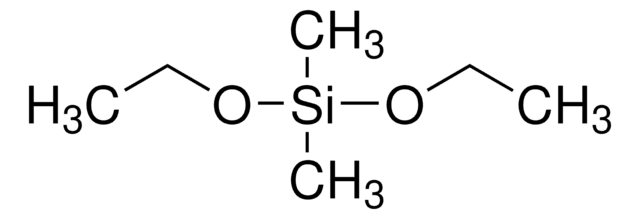371890
3-Aminopropyl(diethoxy)methylsilane
97%
Synonym(s):
3-(Diethoxymethylsilyl)propylamine, 3-Aminopropyl-methyl-diethoxysilane
About This Item
Recommended Products
Quality Level
Assay
97%
form
liquid
refractive index
n20/D 1.426 (lit.)
bp
85-88 °C/8 mmHg (lit.)
density
0.916 g/mL at 25 °C (lit.)
SMILES string
CCO[Si](C)(CCCN)OCC
InChI
1S/C8H21NO2Si/c1-4-10-12(3,11-5-2)8-6-7-9/h4-9H2,1-3H3
InChI key
HXLAEGYMDGUSBD-UHFFFAOYSA-N
Looking for similar products? Visit Product Comparison Guide
Application
- Amino Surface Modification and Fluorescent Labelling of Porous Hollow Organosilica Particles: Optimization and Characterization.: This study showcases the effectiveness of 3-Aminopropyl(diethoxy)methylsilane in modifying the surface properties of porous hollow organosilica particles, enhancing their application in biosensing and drug delivery systems. The modification process improves particle stability and functionality, demonstrating the compound′s utility in high-performance biomedical applications (Al-Khafaji et al., 2022).
- Superelastic Multifunctional Aminosilane-Crosslinked Graphene Aerogels for High Thermal Insulation, Three-Component Separation, and Strain/Pressure-Sensing Arrays.: This research highlights the role of 3-Aminopropyl(diethoxy)methylsilane in producing graphene aerogels with exceptional properties such as elasticity, durability, and multi-functionality. These aerogels are promising for thermal insulation, filtration, and as sensors in automotive and aerospace industries, showcasing the compound′s broad potential in advanced material applications (Zu et al., 2019).
- Improving the Gas-Separation Properties of PVAc-Zeolite 4A Mixed-Matrix Membranes through Nano-Sizing and Silanation of the Zeolite.: Utilizing 3-Aminopropyl(diethoxy)methylsilane for the surface modification of Zeolite 4A, this study enhances the gas-separation efficiency of PVAc-zeolite mixed-matrix membranes. The research addresses significant challenges in membrane-based separation technologies, particularly in the purification processes critical for environmental and industrial applications (Esmaeili et al., 2019).
Signal Word
Danger
Hazard Statements
Precautionary Statements
Hazard Classifications
Skin Corr. 1B
Storage Class Code
8A - Combustible corrosive hazardous materials
WGK
WGK 3
Flash Point(F)
185.0 °F - closed cup
Flash Point(C)
85 °C - closed cup
Personal Protective Equipment
Choose from one of the most recent versions:
Already Own This Product?
Find documentation for the products that you have recently purchased in the Document Library.
Customers Also Viewed
Articles
Mesoporous Oxides and Their Applications to Hydrogen Storage
Our team of scientists has experience in all areas of research including Life Science, Material Science, Chemical Synthesis, Chromatography, Analytical and many others.
Contact Technical Service

![N-[3-(Trimethoxysilyl)propyl]ethylenediamine 97%](/deepweb/assets/sigmaaldrich/product/structures/149/508/f87a9a89-f138-4c5e-9fe0-6561914241c3/640/f87a9a89-f138-4c5e-9fe0-6561914241c3.png)









